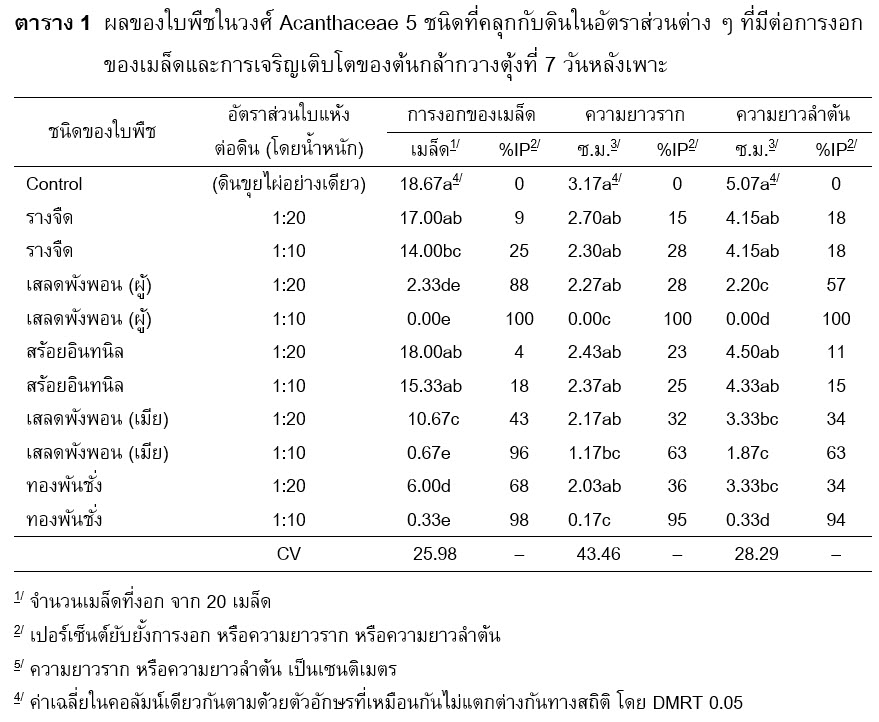ศักยภาพทางอัลลีโลพาทีของใบพืชวงศ์ Acanthaceae บางชนิดในดิน
Main Article Content
Abstract
Chalermchai Wongwattana, Somkiat Phornphisutthimas and Boonrod Chatiyanon
รับบทความ: 20 สิงหาคม 2559; ยอมรับตีพิมพ์: 10 พฤศจิกายน 2559
บทคัดย่อ
จากการศึกษาผลทางอัลลีโลพาทีของใบพืชวงศ์ Acanthaceae 5 ชนิด [รางจืด (Thunbergia laurifolia L.) สร้อยอินทนิล (Thunbergia grandiflora) เสลดพังพอนตัวผู้ (Barleria luplina) เสลดพังพอนตัวเมีย (Clinacanthus nutans (Burm.f) Lindau) และทองพันชั่ง (Rhinacanthus nasutus)] ในดิน โดยผสมใบพืชแห้งกับดินขุยไผ่อัตราส่วน 1:10 และ 1:20 (ใบแห้ง:ดินแห้ง โดยน้ำหนัก) เขย่าให้เข้ากัน เทใส่กระถางพลาสติกขนาดเส้นผ่าศูนย์กลาง 7.5 เซนติเมตร ให้น้ำทางจานรองจนอิ่มตัวแล้วปลูกพืชทดสอบลงในดินผสมนั้นที่ 7 วันหลังปลูก พบว่า เมล็ดกวางตุ้งที่ปลูกในดินผสมใบรางจืดและสร้อยอินทนิลงอกได้ดี โดยเฉพาะที่อัตราส่วน 1:20 ในดินผสมใบเสลดพังพอนตัวผู้ ใบทองพันชั่ง และใบเสลดพังพอนตัวเมีย เมล็ดงอกน้อยที่สุด โดยเฉพาะที่ 1:10 เมื่อตรวจสอบความยาวรากและลำต้นของต้นกล้ากวางตุ้งก็ให้ผลในทางเดียวกับการงอก โดยใบเสลดพังพอนตัวเมีย ใบทองพันชั่ง และเสลด พังพอนตัวผู้ที่คลุกกับดินยับยั้งการเจริญของต้นกล้ามากกว่าใบรางจืดและสร้อยอินทนิล ในการศึกษาการสลายตัวของสารอัลลีโลพาทีจากใบทองพันชั่ง โดยคลุกดินแล้วให้น้ำและทิ้งไว้ 0, 4 และ 7 วันจึงปลูกเมล็ดกวางตุ้งลงไป พบว่า ยิ่งทิ้งดินผสมไว้นานขึ้น เมล็ดกวางตุ้งที่ปลูกลงไปงอกได้มากขึ้น จนไม่แตกต่างจากตัวเปรียบเทียบ การเจริญเติบโตของต้นกล้าหลังงอกก็เช่นเดียวกัน แสดงว่า สารอัล-ลีโลพาทีจากใบทองพันชั่งอาจเกิดการเปลี่ยนแปลงในดินทำให้ฤทธิ์ในการยับยั้งการเจริญเติบโตของพืชลดลง โดยเปอร์เซ็นต์การยับยั้งการงอกลดลงจาก 98.23 เปอร์เซ็นต์ ในเมล็ดที่ปลูกที่ 0 วันหลังคลุกดิน ไปเป็น 67.25 และ 9.45 เปอร์เซ็นต์ ในเมล็ดที่ปลูกที่ 4 และ 7 วันหลังคลุกดิน ตามลำดับ
คำสำคัญ: ศักยภาพทางอัลลีโลพาที Acanthaceae ดิน การงอกของเมล็ด การเจริญของต้นกล้า
Abstract
Allelopathic potential of five Acanthaceae leaves [Thunbergia laurifolia L., T. grandiflora, Barleria luplina, Clinacanthus nutans (Burm.f) Lindau and Rhinacanthus nasutus] in soil were determined by mixing the blended dry leaves with soil at 1:20 and 1:10 ratios [dry leaf: soil (by weight)]. Twenty seeds of Brassica campestris L. were planted in each pot of mixed soil after watering. At 7 days after planting, germination of Brassica seed planted in soil mixed with C. nutans, R. nasutus and B. luphina leaves were lower than those in soil mixed with T. laurifolia and T. grandifolar leaves, especially at the 1:10 ratio (dry leaf: soil). The effect of soil-leaves mixtures on seedling growths after germination were also similar to those on seed germination. These indicated the higher allelopathic potential in soil of C. nutans, R. nasutus and B. luphina leaves than T. laurifolia and T. grandifolar ones. The degradation of allelochemicals from R. nasutus leaf in soil were studied by mixing the blended dry leaf with soil, watering and leaving the soil mixtures for 0, 4 and 7 days before planting the Brassica seeds. At 7 days after planting, number of seed germination in the mixed soils increased with the increase of the leaving periods before planting. The inhibition potential of the 1:10 ratio soil mixture on Brassica seed germination decreased from 98.23% to 67.25% and 9.45% when the mixed soils were left for 0, 4 and 7 days, respectively, before planting. These results showed the reduction of amount or activity of allelochemicals from R. nasutus leaf within 7 days after mixing with soil.
Keywords: Allelopathic potential, Acanthaceae, Soil, Seed germination, Seedling growth
Downloads
Article Details

This work is licensed under a Creative Commons Attribution-NonCommercial 4.0 International License.
References
Chanta, P., and Wongwattana, C. (2006). Allelo-pathy in Ruellia tuberosa Linn. Agricultural Science Journal 37(6) (Suppl.): 455–458.
Kobayashi, K., Itaya, D., Mahatamnuchoke, P., and Pornprom, T. (2008). Allelopathic potential of itchgrass (Rottboellia exaltata L. f.) powder incorporated into soil. Weed Biology and Management 8(1): 64–68.
Kong, C. H., Wang, P., Gu, Y., Xu, X. H., and Wang, M. L. (2008). Fate and impact on microorganisms of rice allelochemicals in paddy soil. Journal of Agricultural and Food Chemistry 56(13): 5043–5049.
Macias, F. A., Oliveros-Bastidas, A., Marin, D., Castellano, F., Simonet, A. M., and Molinillo, J. M. G. (2004). Degradation studies on benzoxazinoides. Soil degradation dy-namics of (2R)-2-O-B-D-glucopyranosyl-4-hydroxy-(2H)-1,4-benzoxazin-3(4H)-one (DIBOA-Glc) and its degradation products, phytotoxic allelochemicals from gramineae. Journal of Agricultural and Food Chem-istry 53(21): 554–561.
Putnam, A. R. (1985). Weed Allelopathy in Weed Physiology. Florida: Boca Raton.
Vidal, R. A., and Bauman, T. T. (1997). Fate of allelochemicals in the soil. Ciência Rural 27(2): 351–357.
Weidenhamer, J. D., and Romeo, J. T. (2004). Allelochemicals of Polygonella myriophylla: chemistry and soil degradation. Journal of Chemical Ecology 30(5):1067–1082.
Wongwattana, C., and Chamchaiyaporn, T. (2014). Allelopathic potential of Cinnamomum spp. leaves in soil. Journal of Research Unit on Science, Technology and Environmental for Learning 5(2): 196–201. (in Thai)
Wongwattana, C., and Phornphisutthimas, S. (2012). Allelopathic potential of some Acanthaceae leaves extracts. Advanced Science Journal 12(2): 151–163. (in Thai)
Wongwattana, C., and Phornphisutthimas, S. (2015). Allelopatic potential of some Apocynaceae leaves. Journal of Research Unit on Science, Technology and Environmental for Learning 6(2): 257–267. (in Thai)
Xuan, T. D., Tawata, S., Khanh, T. D., and Chung, I. M. (2005). Decomposition of allelopathic plants in soil. Journal of Agronomy and Crop Science 191(3): 162–171.
